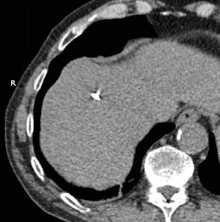Cryoablation
The cryoablation is a technology for arrhythmia in cardiology and cardiac surgery. The heart muscle tissue responsible for the arrhythmia is specifically hypothermic. Cold has been used to treat cardiac arrhythmias for decades. Today arrhythmias can be treated with minimally invasive catheter ablation or with a surgical probe. Because cryotherapy freezes the cells - unlike heat-based radiofrequency ablation - it represents an alternative treatment option for electrophysiologists and cardiac surgeons .
The tip of the cryoablation catheter is cooled down to temperatures below 0 ° C. Heat is extracted from the surrounding tissue via the tip of the catheter. Depending on the catheter used, temperatures of -75 ° C or even colder occur at the catheter tip. This cold is not perceived by the patient.
The heart muscle cells responsible for the conduction of the arrhythmia are changed by the exposure to cold so that they can no longer conduct electrical excitations.
Testing the ablation site
In contrast to heat-based ablation, cryoablation has several advantages. If heart muscle cells are only cooled slightly, the doctor can test the tissue for the desired effect before creating a permanent lesion. If the catheter is not positioned in the right place or if undesirable effects occur, the cold treatment is stopped and the tissue warms up again to normal body temperature. Some doctors appreciate the safety of this test before creating permanent sclerosing that may be ineffective at this point.
Lower risk of AV node obstruction
The AV node is part of the conduction system and forwards the electrical pulses from the atria to the ventricles. If tissue is ablated near the AV node, there is a risk of blocking this AV node line - that is, normal excitation of the atria can no longer be transmitted to the ventricles. In this case, a pacemaker must be implanted (inserted). Understandably, AV node obstruction is a complication that should be avoided. Some clinicians appreciate the testing capabilities of cryoablation because procedures close to the AV node are less likely to block the AV node than when using heat.
Less pain
In contrast to ablation with heat, cryoablation is largely painless.
Success rates
The success rate of cryoablation therapy is high, but varies depending on the type of arrhythmia being treated. In general, the success rate is comparable to that of heat-based ablation procedures. Recent experience and studies show that in some cases cryotherapy is safer than conventional radiofrequency ablation . In particular if the region to be treated is very close to sensitive structures of the heart such. B. the AV node.
Cryotherapy in cardiac surgery
As with catheter-based procedures, cold can be used in cardiac surgery to treat arrhythmias. In surgical procedures, a flexible probe is placed on the heart either from the inside ( endocardially, e.g. as part of a mitral valve operation) or from the outside ( epicardially, e.g. during bypass operations ). As a result of the cold, the heart muscle tissue, which is responsible for the arrhythmia, is scarred. A lesion is created which can no longer conduct electrical stimuli. This prevents an arrhythmia or its spread.
literature
- Jensen-Urstad et al .: Cryoablation of AV Nodal Reentrytachycardia. PACE. Vol. 29, May 2006, p. 487.
- Nicolas Doll, Alexander Max Fabricius, Ralf Meyer, Thomas Walther, Ardawan Rastan, Friedrich Wilhelm Mohr: Surgical treatment of atrial fibrillation with argon-based cryotechnology. In: Future Cardiology. May 2005, Vol. 1, No. 3, 381-391.


